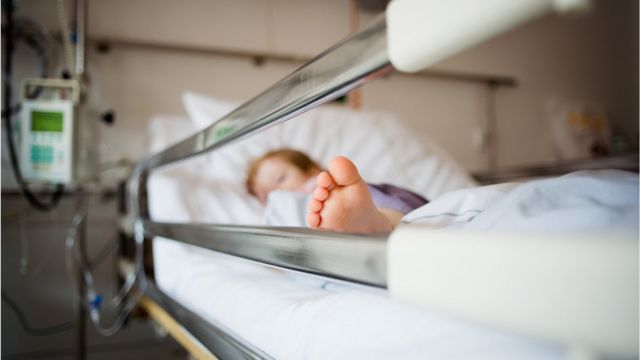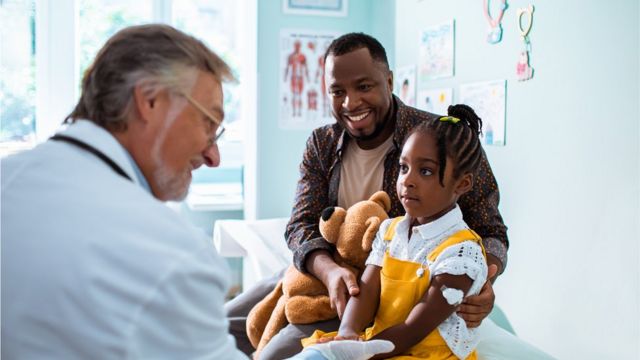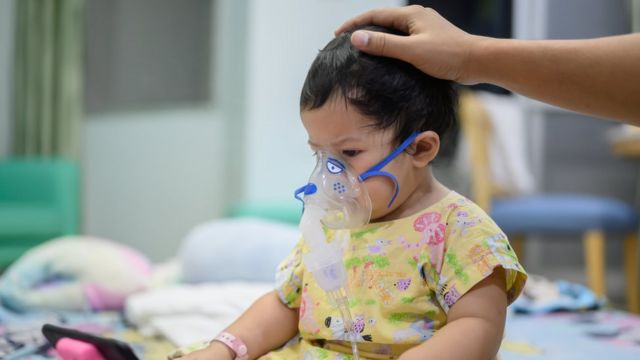In early 2021, staff at Maimonides Children’s Hospital in Brooklyn, New York, were beginning to feel a wary sense of relief.
Covid-19 cases in the city were falling down.
As a side effect of social distancing, wearing face masks and hand washing, they had also seen far fewer other viral infections, such as the flu.
But then, in March, a growing number of children and babies with coughs began arriving, some of them with difficulty breathing
They were infected patients virus respiratorio sincitial (VRS, also known as RSV), a common winter infection that can cause lung problems.
At this time of year, RSV cases should be on the decline. Instead, the number of infections was elevating.
During the following months, the sudden and unexpected increase VRS at this time of year began to be noticed as far away as the southern US, Switzerland, Japan or the UK.
The strange behavior of the virus appears to be a indirect consequence from the covid-19 pandemic, doctors say.
Sudden increase
In 2020, lockdowns and hygiene measures suppressed the spread of the coronavirus, but also other viruses such as RSV.
As a result of these measures, the children did not have the opportunity to develop immunity against viruses such as RSV.
Once the measurements were relaxed, the VRS found a large number of infants and children susceptible to infection, causing drastic increases in infections at unusual times.
What was commonly a fairly predictable virus now had the ability to take by surprise to hospitals and families at any time of the year.
These unexpected outbreaks pushed the wards of some hospitals to the limit, they put the families on alert and they showed how profoundly COVID-19, and measures to prevent its spread, had disrupted the world.
For healthcare workers, the experience was dramatic.
“Our intensive care unit was once again overflowa, this time not with cases of covid, but with another virus “, recalls Rabia Agha, director of the Division of Pediatric Infectious Diseases of the Maimonides Children’s Hospital.
At the peak of the outbreak, in early April, most of the children admitted to the ICU were RSV patients.
In other parts of the world, the virus spread in populations of young children who for months had been protected from infectious diseases but were now suddenly exposed to them.
“It took us by surprise. We knew it was something to watch out for, but we didn’t think there would be that many“Says Christoph Berger, head of the Department of Infectious Diseases and Hospital Epidemiology at the University Children’s Hospital in Zurich, Switzerland.
At that center, RSV cases typically peak in January, hovering around zero in the summer months, June through August.
This year there were no cases in winter. Instead, they began to rise sharply in June, then they shot up to 183 infections in July, more than in previous winter seasons.

“We were full, all the beds were taken, and that’s a challenge,” Berger recalls of the peak of the outbreak in July.
Your hospital had to transfer babies and children with RSV to other hospitals that still had space. Several other Swiss hospitals had to do the same.
During the summer in Switzerland, VRS meant a major problem than the coronavirus.
“We had almost no covid cases during that period,” says Berger.
The few children who came to the hospital with covid recovered relatively quickly. “Those with RSV stayed longer,” he says.
Treatment
An RSV infection is not in itself a cause for alarm.
According to the US Centers for Disease Control and Prevention, most children will have had RSV by the age of 2.
For almost all of them it will be a cold-like illness, with a runny nose and cough, and they will recover on their own.
But in some babies and young children, RSV can cause bronchiolitis, an inflammation of the lower parts of the lung.
They may also have trouble breathing and feeding.

About 1% to 2% of babies younger than 6 months with RSV should be taken to the hospital and receive extra oxygen through a mask, or tubes in the nose to help them recover.
Some may also require a feeding tube. With this treatment, most will improve within a few days.
Before the coronavirus pandemic, hospitals routinely prepared for RSV surges before winter.
Patients at higher risk, such as premature babies and those with lung and heart problems, can be protected with palivizumab, a antibody injection which helps fight the virus.
The injection should be given every month during the months that RSV is active, another reason why prepare for increased cases it’s so crucial.
Skip a season
The pandemic has disrupted the seasonal rhythm of RSV and its role in the habitual development of children’s immunity.
“With the measures we had for the covid, people did not meet, did not travel and they were careful about distancing themselves and using the mask,” says Agha.
“That really helped keep covid and all other viruses at bay. So it was like skipping a season of VRS. And if you skip a season, you are not producing antibodies against the virus, and mothers are not producing antibodies that they can then pass on to their babies. “
As a result, those babies can be particularly vulnerable to VRS when the world reopens.
Data from different countries support the idea of a immunity gap caused by a season without RSV.
“The largest relative increase in cases occurs in one-year-old children, who ‘lost’ a season of VRS this past autumn-winter, ”officials from England’s Public Health office explained in an email to the BBC, referring to the sudden increase in cases in some parts of England during the summer.
Skipping a season increases the pool of vulnerable babies and children, including those who were protected during the winter, as well as those born since then.
That can make viral waves be stronger.
In Tokyo, researchers have reported the highest annual increase RSV cases since monitoring began in 2003.
Their data suggest that accumulation of vulnerable people during the pandemic may have contributed to this year’s unusually large outbreak.
Questions without answer
Other aspects of the new viral panorama still are not clear.
One of them is why VRS resurfaced once anti-covid measures were relaxed, but the same did not happen with the flu, which has remained fairly moderate.
The pattern of the RSV surge has also varied from country to country.
Agha and her team in Brooklyn noted that her increase was unusually severe, affecting children much smaller than usual and sending a greater proportion to intensive care.
In Australia, on the other hand, it affected an older group than before.

Berger says the summer outbreaks in Switzerland had been no more severe than typical winter viral outbreaks.
A big question is what does this mean new pattern for the next few months.
A sudden increase in cases during the summer does not necessarily mean that there will be no more cases in the winter. And in some areas, the cases are only starting to increase now, early fall.
“RSV, and the bronchiolitis it causes, is definitely the key issue for which children’s hospitals are turning. planning“Says Sophia Varadkar, deputy chief medical officer and pediatric neurologist at Great Ormond Street Children’s Hospital in London.
In that hospital, cases have started to increase and they expect more in the coming weeks.
For those caring for babies, RSV can be a major concern than covid-19, warns Varadkar.
“The covid for children, in general, was not a significant disease. It didn’t make a lot of kids feel really bad. “
“RSV is a potentially major disease, [afectando] to many more children, and we definitely know that you can make those babies feel bad “, he points out.
Care measures
With the reopening of schools, viruses, including RSV, will have more opportunities to spread.
But adult behavior can be even more crucial.
In Switzerland, nurseries and play facilities remained open throughout the winter and young children did not wear masks.
Almost no children contracted viral infections such as RSV and the flu that winter, presumably because adult hygiene measures they helped protect them.
“People always say that children infect adults, but if you think about it, that was not the case at all here, it was the other way around,” says Berger.
“When adults and older children wear masks, maintain social distancing, and wash their hands, we don’t see the flu or RSV. And when they relax those measures, the virus circulates again and more young children end up in the hospital. “
Even after the summer surge, your hospital remains on guard. “I have no idea how this will continue, and if that was all the cases, or if we will see another wave in winterI don’t know, ”says Berger.
Washing your hands and keeping vulnerable babies away from people with a runny nose and cough can help prevent the spread of infection.
It can also flatten the high point of an RSV epidemic by ensuring that hospitals have the right to ability to care for everyone children who need help.
“For most children it will be a mild sickness, they will be able to be cared for by their parents, they only need care, to eat more frequently, rest, some paracetamol if they have a fever, and that’s it ”, says Varadkar.
But if the baby has difficulty breathing or feeding, or if the parents feel that something is not right, they should to look for help, clarifies the expert.
Lesson for the future
At Maimonides Children’s Hospital in Brooklyn, he has passed the high point of VRS.
But Agha draws a lesson for hospitals adapting to the post-covid-19 world.
“What he taught us was that you have to be prepared“, Highlights. “These are not the same times as two years ago: llife has changed, the world has changed and these viruses are evolving and behaving in unexpected ways ”.
eltiempolatino.com